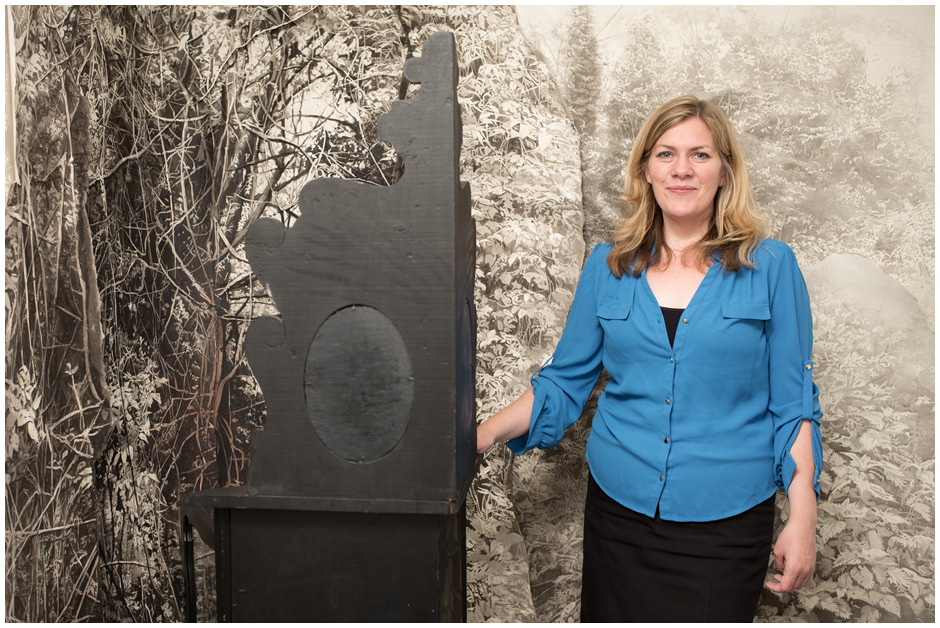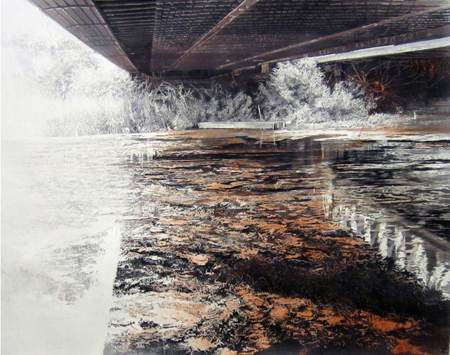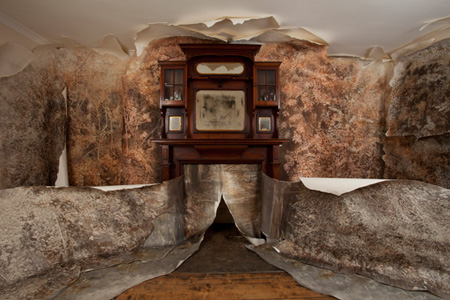Millie Walton meets the artist and talks to her about her new series, cultivating lucid landscapes and blurring Victorian folkelore
 When I meet Juliette Losq, she’s in the process of installing artwork for her first solo exhibition at The Fine Art Society on New Bond Street. Swathes of paper lie strewn over the floor and large bubble-wrapped pieces of furniture are propped up against the walls. It’s not often you get to see an exhibition take shape – it feels exciting, and I expect Juliette to be rushing around, chaotic, stressed, “no time to talk”. Instead, she’s sitting on a sofa, calmly watching the gallerists measure up a corner alcove to see whether the grandfather clock will fit.
When I meet Juliette Losq, she’s in the process of installing artwork for her first solo exhibition at The Fine Art Society on New Bond Street. Swathes of paper lie strewn over the floor and large bubble-wrapped pieces of furniture are propped up against the walls. It’s not often you get to see an exhibition take shape – it feels exciting, and I expect Juliette to be rushing around, chaotic, stressed, “no time to talk”. Instead, she’s sitting on a sofa, calmly watching the gallerists measure up a corner alcove to see whether the grandfather clock will fit.
The clock’s a component of one of the three installations that will feature, called ‘Pendalous’ (Latin for pendulous), a reference to a drawing that comes out from underneath it, undulating across the floor “like a stream coming along the centre of the gallery.” Like most of the pieces of furniture the London-based artist acquires for her installations, comes from eBay – “it’s quicker than trawling through antique shops” – and it’s got no face or internal workings. “I think grandfather clocks are really interesting objects, they’re very anthropomorphic. They’re almost at the proportions of a human. You’re looking into what would be the face. There’s also mythology behind them, there’s a song written about a grandfather clock, simply called ‘My Grandfather’s Clock’. The clock stops at the same time the grandfather dies and its been ticking since he was born. It’s Victorian melodrama.”


Juliette’s fascination with folklore and history, in particular Victorian and Rococo, almost makes her work itself seem of another time. Often characters or creatures – the sort you might find in the darker variety of fairy stories – peep out from the tangled, wilderness of her large landscapes, yet traces of the contemporary remain through graffitied walls or cracked, industrial barrels. “I like to look at landscapes where a trace of human activity has gone on; or you can project an idea of a hidden history; or there’s just some suggestion of human agency in there somewhere although there are never any people present.” That’s also the reason for including furniture in her installations. She explains, “It’s like the book, The Yellow Wallpaper, by Charlotte Perkins Gilman. In that, the woman is projecting activities onto something that she’s been staring at for a long time and I think, for me, the furniture acts in the same way. Its like a conduit to project our imagination onto.”
The worlds Juliette depicts are created from collages of photos taken in the suburbs of London. “You get lots of disparate places combined to make a new place.” She incorporates elements of old architecture or characters from ancient tales into them, “I’ve got a really amazing scrap book where someone from Victorian times has gone through cheap magazines and cut out lots of different pictures and made little new pictures from them. I’ve never actually used anything from it yet but I might at some point. I sort of go back and forth. I might have had stuff on my wall for five years and not done anything with it and suddenly it will just feed into something.”
Her latest body of work has been collectively titled, Nemora, a reference to “nemus”, described in Jacob Grimm’s Teutonic Mythology as being “a woodland pasture, a grove, a sacrum silvae” or in Juliette’s words, a “clearing.” I ask what this means in reference to her work, “You’re constantly fighting nature from overtaking, yet you’ve made a clearing within nature and you’re sort of protecting your boundaries”, she says. “The minute those boundaries are crept over it, becomes mildly threatening and that’s why I think these spaces are interesting. I like the idea of something bordering on the edge of slightly dangerous and at the same time being quite enticing.”
We pause in front of a drawing of water under a bridge. Juliette points out the presence of an insect like creature lurking in the darkness. “This one’s called Scumsucker”, she laughs. The next image features an octopus strangling someone. I ask her if all of her work deals with death. “It’s the fear of death and the unknown, but also acknowledging that it’s part of nature. I’m interested in superstitions and cautionary tales, the idea that we are warned against going into places but we still want to go into them.”
I’m not sure they’re the type of landscapes I’d like to find myself within physically, but to look at, they’re utterly mesmerising, as though the drawings are playing a game, leading you to search for hidden eyes or objects, sometimes revealing them sometimes not. “I’ve had people see characters, which I’ve forgotten are there or aren’t even there in the first place.”
Photography Robin Sinha
Juliette Losq: Nemora runs 12 September until 2 October. Click for more information




